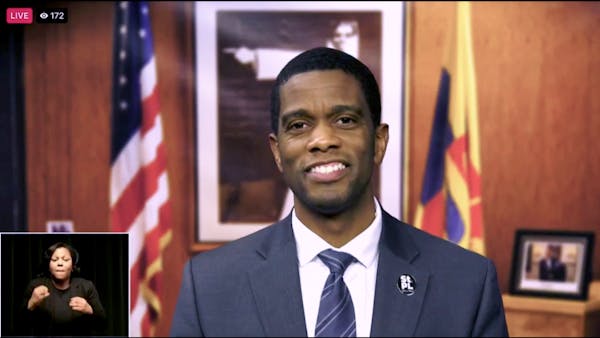It's been more than six weeks since the Twin Cities reinstated indoor mask mandates amid a surge of COVID-19 infections and hospitalizations fueled by the highly contagious omicron variant.
Since then, the mayors of Minneapolis and St. Paul have said they are monitoring promising trends as they consider whether to rescind the requirements, as they did last summer after a large percentage of the community received COVID-19 vaccinations.
Some other governments — at the local, state and national levels — have already rolled back mask mandates as the omicron wave recedes. Minneapolis and St. Paul have not. Here's what we know about the Twin Cities' masking requirements:
Why do we have mask mandates?
The omicron variant of COVID-19 was classified by the World Health Organization in late November, and the United States recorded its first case of the variant on Dec. 1. In the weeks that followed, communities around the world began to experience rapid spikes in infections due to omicron, which is more contagious than the other variants of the virus that causes COVID-19.
Minnesota began to see its own caseload mount. On Jan. 5, Mayors Jacob Frey and Melvin Carter announced that they were reviving the Twin Cities' indoor masking requirements, citing a surge of cases and hospitalizations from the omicron variant.
Minneapolis requires masking in "areas of public accommodation," while St. Paul's order applies to businesses licensed by the city.
A week later, as COVID-19 trends worsened, the mayors jointly enacted emergency executive orders that required customers to show proof of vaccination or a negative COVID-19 test to enter restaurants, bars and other entertainment venues.
How bad did it get?
The actions came as mayors of both cities were trying to temper a spike in infections, which caused staffing shortages across industries and prompted Gov. Tim Walz to spend $40 million in federal pandemic relief to shore up staffing in hospitals.
The federal Centers for Disease Control and Prevention (CDC) considers counties recording more than 100 infections per 100,000 residents in the last seven days to be "high transmission" areas where everyone should wear a mask in public, indoor settings.
In early January, the Twin Cities far exceeded that threshold. Minneapolis was reporting more than 1,300 cases per 100,000 people, according to the city. Ramsey County recorded a rate of almost 1,900 cases per 100,000 by Jan. 26, according to the county's COVID-19 dashboard.
Is it over?
In recent weeks, numbers have fallen dramatically in both cities and across the state. Minnesota's COVID-19 hospitalizations dropped below 1,000 last week for the first time since early November.
Yet, the threat remains.
As of Sunday, Ramsey County was reporting about 250 infections per 100,000 people in the last seven days — a significant decrease from a few weeks ago, but still above the CDC's high-transmission threshold. Minneapolis has seen a similarly drastic decline in cases. As of Feb. 18, the new daily case rate in Minneapolis has been 109 per 100,000 people, down from 900 the month before, according to preliminary data on the city's COVID-19 dashboard.
How have governments reacted?
Many states and major cities that enacted mask mandates have rescinded them in recent weeks. Even some school districts in Minnesota, where the spread was a big concern, are scrapping the requirements.
Both Minneapolis and St. Paul got rid of their vaccination or test requirements Feb. 10, when both mayors said data made them feel comfortable rescinding what Minneapolis interim Health Commissioner Heidi Ritchie called the "more invasive" regulation.
Will a change come soon?
The CDC has said it is contemplating a change to its masking guidelines — which cities and others look to when drafting their own policies — as soon as this week, according to national media outlets.
The state on Wednesday will release updated outbreak figures that would include cases for this week, which also inform local public health officials.
Mayors of both cities have said they are working closely with public health authorities to keep an eye on a variety of indicators. In a recent interview, Carter said there is no "carved-in-stone threshold" the city needs to meet to rescind its mask mandate, adding that guidance from the state and federal levels have been key to all of St. Paul's decisions regarding pandemic restrictions.
Tara Niebeling, a spokeswoman for Frey, said Monday that the mayor is "working in coordination with health experts to plan for how Minneapolis enters the next phase of this pandemic."

Fall or spring, it's Rochester Mayo's year in prep tennis

Minneapolis reaches $150k settlement with eyewitness of George Floyd's murder

Israel-Hamas war creates 'really fraught times' at Minn. colleges

Rare and fatal brain disease in two deer hunters heightens concerns about CWD

